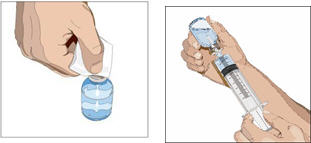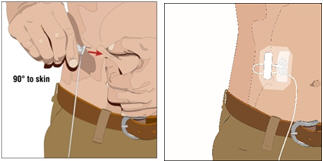CUVITRU Solution for injection Ref.[27466] Active ingredients: Human normal immunoglobulin G
Source: FDA, National Drug Code (US) Revision Year: 2021
1. Indications and Usage
CUVITRU is an Immune Globulin Subcutaneous (Human) (IGSC), 20% Solution indicated as replacement therapy for primary humoral immunodeficiency (PI) in adult and pediatric patients two years of age and older. This includes, but is not limited to, common variable immunodeficiency (CVID), X-linked agammaglobulinemia, congenital agammaglobulinemia, Wiskott-Aldrich syndrome, and severe combined immunodeficiencies1,2.
2. Dosage and Administration
For subcutaneous administration only. Do not administer intravenously or intramuscularly.
2.1 Preparation and Handling
- Inspect the drug product visually for particulate matter and discoloration prior to administration. CUVITRU is a clear and colorless or pale yellow or light brown solution and clear of particulate matter. Do not use if the solution is cloudy, turbid, or if it contains particulates.
- Do not mix CUVITRU with other products.
- Do not shake.
- Do not dilute.
- CUVITRU vial is for single use only. Any vial that has been entered should be used promptly. Partially used vials should be discarded. CUVITRU contains no preservative.
- Record the name and lot number of the product in the recipient’s records.
2.2 Dose
- CUVITRU can be administered at regular intervals from daily up to every two weeks (biweekly).
- Individualize the dose based on the patient’s pharmacokinetic and clinical response.
- Monitor serum IgG trough levels regularly to guide subsequent dose adjustments and dosing intervals as needed (see Dose Adjustment).
For patients switching from Immune Globulin Intravenous (Human) treatment (IGIV) or adult patients switching from HYQVIA [Immune Globulin Infusion 10% (Human) with Recombinant Human Hyaluronidase]:
- Begin treatment with CUVITRU one week after the patient’s last IGIV or HYQVIA infusion.
- Establish the initial weekly dose by converting the monthly IGIV or HYQVIA dose into an equivalent weekly dose and increasing it using a dose adjustment factor.
- To calculate the initial weekly dose, divide the previous IGIV or HYQVIA dose in grams by the number of weeks between intravenous doses; then multiply this dose by the dose adjustment factor of 1.30.
Initial Weekly dose = Previous IGIV or HYQVIA dose (in grams) / Number of weeks between IGIV or HYQVIA doses X 1.30
- To convert the dose (in grams) to milliliters (mL), multiply the calculated dose (in grams) by 5.
- Doses divided over the course of a week, or once weekly, or biweekly, achieve similar exposure when administered regularly at steady-state.
- To determine the dose for alternative regular dosing intervals:
- Frequent dosing (2-7 times per week): Divide the calculated weekly dose by the desired number of times per week.
- Biweekly dosing: Multiply the calculated weekly dose by 2.
To guide dose adjustments, see section Dose Adjustments (Table 1).
For patients switching from Immune Globulin Subcutaneous (Human) treatment (IGSC):
- The weekly dose of CUVITRU (in grams) is recommended to be the same as the weekly dose of prior IGSC treatment (in grams).
- Doses divided over the course of a week, once weekly, or biweekly, achieve similar exposure when administered regularly at steady-state.
- To determine the dose for alternative regular dosing intervals:
- Frequent dosing (2-7 times per week): Divide the calculated weekly dose by the desired number of times per week.
- Biweekly dosing: Multiply the calculated weekly dose by 2.
- To convert the dose (in grams) to milliliters (mL), multiply the calculated dose (in grams) by 5.
To guide dose adjustments, see section Dose Adjustments (Table 1).
For patients at risk for measles exposure:
- If a patient has been exposed to measles, it may be prudent to administer a dose of Immune Globulin Intravenous as soon as possible and within 6 days of exposure. A dose of 400 mg/kg should provide a serum level >240 mIU/mL of measles antibodies for at least two weeks.
- If a patient is at risk of future measles exposure and receives a dose of CUVITRU of less than 230 mg/kg subcutaneously per week, the dose should be increased to at least 230 mg/kg per week, or the weekly equivalent of 230 mg/kg for dosing intervals other than weekly.
Dose Adjustment
To guide dose adjustment, calculate the difference between the patient’s target serum IgG trough level and the IgG trough level during subcutaneous treatment. Find this difference in Table 1 and the corresponding amount (in mL) by which to increase (or decrease) the weekly/biweekly dose based on the patient’s body weight. If the difference between measured and target trough levels is less than 100 milligram/dL, then no adjustment is necessary. However, the patient’s clinical response should be the primary consideration in dose adjustment.
Table 1. Change in Volume to Be Administered Weekly/Biweekly for Intended IgG Trough Level Change*:
| Body Weight | ||||||
|---|---|---|---|---|---|---|
| Difference from Target Serum IgG Trough Levels | Dosing Frequency | 30 kg | 50 kg | 70 kg | 90 kg | 110 kg |
| 100 mg/dL | Weekly | 3 mL | 5 mL | 7 mL | 9 mL | 11 mL |
| Biweekly | 6 mL | 10 mL | 13 mL | 17 mL | 21 mL | |
| 200 mg/dL | Weekly | 6 mL | 10 mL | 13 mL | 17 mL | 21 mL |
| Biweekly | 12 mL | 19 mL | 27 mL | 35 mL | 42 mL | |
| 300 mg/dL | Weekly | 9 mL | 14 mL | 20 mL | 26 mL | 32 mL |
| Biweekly | 17 mL | 29 mL | 40 mL | 52 mL | 63 mL | |
* Derived using a linear approximation of trough levels and weekly dose per kg body mass with a slope of 52.1 kg/dL.
Example 1: A patient with a body weight of 70 kg who is on a weekly treatment has a measured IgG trough level of 600 milligrams/dL, and the target trough level is 800 milligrams/dL. The desired target trough level difference is 200 milligrams/dL (800 milligrams/dL minus 600 milligrams/dL). The weekly dose of CUVITRU should be increased by 13 mL.
Example 2: A patient with a body weight of 50 kg who is on a biweekly treatment has a measured IgG trough of 900 milligrams/dL, and the target trough level is 700 milligrams/dL. The desired target trough level difference is 200 milligrams/dL (900 milligrams/dL minus 700 milligrams/dL). The biweekly dose of CUVITRU should be decreased by 19 mL.
2.3 Administration
Table 2. Infusion Volume and Rate*:
| Infusion Parameters | First 2 Infusions | Subsequent Infusions | ||
|---|---|---|---|---|
| Patients <40 kg | Patients ≥40 kg | Patients <40 kg | Patients ≥40 kg | |
| Volume (mL/site) | ≤20 | ≤60 | ≤60 | |
| Rate (mL/hr/site) | 10-20 | ≤60 | ||
* If the initial infusions are well tolerated then subsequent infusions can begin at the maximum tolerated rate
Selection of Infusion Site: Suggested areas for subcutaneous infusion of CUVITRU are abdomen, thighs, upper arms, or lateral hip. CUVITRU may be infused into multiple infusion sites. Use up to 4 sites simultaneously. Infusion sites should be at least four inches apart, avoiding bony prominences. Rotate sites with each administration.
Volume per Site: To calculate the number of sites to be used, divide the total volume to be infused by the maximum volume/site (up to 60 mL/site) to be infused. Simultaneous subcutaneous infusion at multiple sites can be facilitated by use of a multi-needle administration set.
Infusion rate: For the first two infusions of CUVITRU, the recommended infusion rate is 10-20 mL/hr/site. For subsequent infusions, the infusion rate may be increased to 60 mL/hr/site as tolerated (e.g., 60 mL/hr/site × 2 sites = 120 mL/hr). For patients utilizing 4 infusion sites, the maximum infusion rate for all sites combined is 240 mL/hr.
Instructions for Administration
Use aseptic technique when preparing and administering CUVITRU for infusion.
1. Inspect the vials: Inspect for clarity, color, and expiration date(s). [See Dosage and Administration (2.1)]
2. Prepare for infusion:
- Gather supplies: CUVITRU vial(s), ancillary supplies, sharps container and infusion pump.
- Prepare a clean work area.
- Wash hands.
3. Prepare the CUVITRU:
- Wipe each stopper with a sterile alcohol wipe and allow to dry.
- Transfer into syringe(s), preferably using a vented spike.
- Start the infusion promptly after drawing CUVITRU into the syringe. It is suggested to complete the administration within 2 hours due to the potential formation of particles caused by siliconized syringes.
4. Prepare the infusion pump and tubing:
- Follow manufacturer directions for priming the tubing and pump usage.
- Attach the syringe filled with CUVITRU to the needle set.
- Prime the needle set up to the needle hub.
5. Prepare the infusion site(s):
- Potential sites for infusion include the abdomen, thighs, upper arms, or lateral hip.
- Avoid: bony areas, visible blood vessels, scars and any areas of inflammation (irritation) or infection.
- The number and location of infusion sites depends on the volume of the total dose.
- Infusion sites should be at least 4 inches apart.
- Rotate sites of the body between successive infusions.
- Cleanse the infusion site(s) with a sterile alcohol wipe beginning at the center of each infusion site and moving outward in a circular motion. Allow the infusion site(s) to dry.
6. Insert and secure the subcutaneous needle set:
- Pinch at least one inch of skin between two fingers. Insert the needle at a 90-degree angle into the subcutaneous tissue and secure the needle with sterile tape.
- If more than one site is used, repeat steps.
- Secure the needle in place with a sterile protective dressing.
7 Start the infusion of CUVITRU based on prescriber’s order:
Follow the manufacturer’s instructions to turn on the infusion pump.
8. Remove subcutaneous needle(s) from the infusion site(s):
After the infusion is complete, remove the needle set and cover with a protective dressing. Discard any partially used vial(s) and disposable supplies in accordance with local requirements.
9. Document the infusion:
Remove the peel-off label from each vial of CUVITRU used and affix to the patient’s treatment record or infusion log. In addition, record the time, date, dose, infusion site location and any reactions after each infusion.
For self-administration, provide the patient with instructions and training for infusion in the home or other appropriate setting.
16.2. Storage and Handling
- Store at refrigeration temperature: 2°C to 8°C [36°F to 46°F] for up to 36 months or
- Room temperature: not to exceed 25°C [77°F]) for up to 24 months.
- Do not return CUVITRU to the refrigerator if you take it out to room temperature.
- Do not freeze.
- Do not shake.
- Keep the vials in the carton in order to protect from light.
- Discard any unused product.
- Do not use past the expiration date.
© All content on this website, including data entry, data processing, decision support tools, "RxReasoner" logo and graphics, is the intellectual property of RxReasoner and is protected by copyright laws. Unauthorized reproduction or distribution of any part of this content without explicit written permission from RxReasoner is strictly prohibited. Any third-party content used on this site is acknowledged and utilized under fair use principles.


